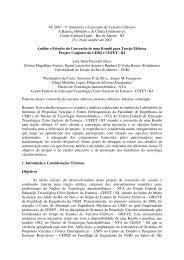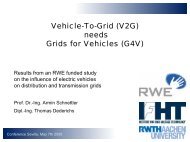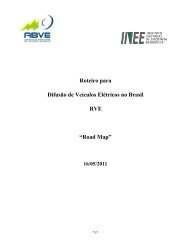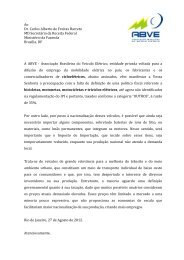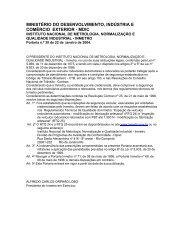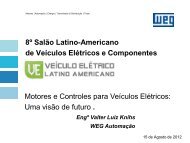Manitoba's Electric Vehicle Road Map - Government of Manitoba
Manitoba's Electric Vehicle Road Map - Government of Manitoba
Manitoba's Electric Vehicle Road Map - Government of Manitoba
- No tags were found...
Create successful ePaper yourself
Turn your PDF publications into a flip-book with our unique Google optimized e-Paper software.
the numbers game:how manitoba stacks upThere are currently more than 700,000motorized vehicles operating in<strong>Manitoba</strong>. All but a select few requirefossil fuels (gasoline or diesel) tooperate. <strong>Manitoba</strong>ns use about 1.5billion litres <strong>of</strong> gasoline and one billionlitres <strong>of</strong> diesel fuel annually.Our overall fuel consumption per vehicleis also fairly high. For example, theaverage gasoline-powered vehicle usesaround 15 litres per one-hundredkilometres. This high fuel consumptionis due, in part, to <strong>Manitoba</strong>’s cold winterconditions. As well, a great many lighttrucks and SUVs are purchased by<strong>Manitoba</strong>ns, particularly in urban areas.<strong>Manitoba</strong> does produce some crudeoil, but quantities are limited, and it’sexported for further processing. Thekey fact is, all refined gasoline and dieselbought at the pump is imported into<strong>Manitoba</strong>, so the payment for these fuelsflows out <strong>of</strong> province.Paying for our reliance on fossil fuel hasbecome <strong>Manitoba</strong>’s number-one energyweakness. By the mid-1990s, the moneyleaving <strong>Manitoba</strong> to pay for all importedfossil fuels was about $1 billionannually. In 2011, this amount has morethan doubled – it’s in the range <strong>of</strong> $2 to$3 billion annually.That money is lost to <strong>Manitoba</strong>’seconomy. As the costs <strong>of</strong> fossil fuelsincreases, those losses will continue togrow. Every 20-cent increase at the pumpequates to roughly $500 million moreleaking from the <strong>Manitoba</strong> economy. Thisis enough to pay the entire annualelectricity bill <strong>of</strong> every <strong>Manitoba</strong> family.The fossil fuel used for transportation isalso one <strong>of</strong> the largest sources <strong>of</strong> GHGemissions in <strong>Manitoba</strong> – more thanseven million tonnes. Transportationrepresents more than one-third <strong>of</strong> all the<strong>Manitoba</strong> GHG emissions.manitoba’selectrifyingadvantagesIt only makes sense for <strong>Manitoba</strong>ns touse electric and plug-in hybrid electricvehicles to the greatest extent possible.We have “green” fuel<strong>Manitoba</strong> Hydro is well-recognizedfor having the highest proportion <strong>of</strong>renewable electricity generation (98 percent-plus) in its grid-mix in all <strong>of</strong> NorthAmerica. With new hydroelectric andwind projects, we can even surpass that.<strong>Manitoba</strong> drivers will not only savemoney by refueling with electricity, theywill also make deep, sustainable cuts inthe associated emissions. If all 10 billionvehicle-kilometres now travelled in<strong>Manitoba</strong> using gasoline, were electricallypowered, it would require somewherein the range <strong>of</strong> a 300 to 700 MW windfarm. And it would result in 3 to 4 milliontonnes <strong>of</strong> GHG emission reductions.We have the right price<strong>Manitoba</strong> has among the lowest electricityrates in North America. This meansthat for electric and plug-in hybrid electricvehicles, we have the lowest priced elec-Westward Industries’ made-in-<strong>Manitoba</strong> hybrid Go4 Interceptor III.Photo courtesy <strong>of</strong> Westward Industriestric fuel on the continent. We could easilyconvert one <strong>of</strong> our greatest energy weaknesses(imported fossil fuels) to one <strong>of</strong>our greatest strengths (hydroelectricity).The cost to “fill ‘er up” with electricityhas been estimated in the range <strong>of</strong> 6¢ to20¢ per litre, gasoline equivalent. (Note:Gasoline-equivalent costs also dependon the vehicle.) As well, electricity pricesare stable and predictable – the pricedoesn’t spike because it’s a long weekend,or summer, or because <strong>of</strong> events inthe Middle East.We have the infrastructure<strong>Manitoba</strong> has more than half-a-millionplug-in points in our homes, garages,businesses and parking lots. These arealready used for block heaters andpreheating vehicles. They can easily beused for electric vehicle recharging.That existing infrastructure accommo-dates what’s referred to as “Level 1”charging. While slower than higher voltage“Level 2” charging systems, “Level1” can be a practical solution in the nearterm for electric and plug-in electricvehicles used primarily for commutingshorter distances.For other jurisdictions to put in place500,000 recharging systems would costthem over $1 billion. <strong>Manitoba</strong> has thisrecharging infrastructure already in placetoday, <strong>of</strong>fering a significant advantageand substantial investment savings.We know how to “plug in”<strong>Manitoba</strong> also has a well-establishedplug-in culture for vehicles – it’s calledwinter. We don’t need special trainingcourses to teach people how to plug intheir vehicles. We’ve been doing it sincewe learned to drive.
manitoba’selectric vehicle road map:shifting into driveWhat we know:• the scale <strong>of</strong> the opportunity before<strong>Manitoba</strong> is clear• <strong>Manitoba</strong> has many assets to speedthe transition from fossil fuel to clean,renewable transportation energy• this transition will not happenovernight• we can’t control the pace at whichelectric vehicles are made available inthe marketplaceWhat we can do:• focus on maximizing our advantages• create the relationships and environmentnecessary to fast track electricvehicles into <strong>Manitoba</strong> as theybecome available• make the transition as swift, cost-effectiveand comprehensive as possibleAs this energy revolution begins tounfold, <strong>Manitoba</strong>’s early actions on theroad to electric vehicles will include:1. Plug-in Partnerships<strong>Manitoba</strong> will facilitate partnershipswith automakers, electric technologyproviders, <strong>Manitoba</strong> Hydro, <strong>Manitoba</strong>companies, academic institutions andothers to:fossil fuel freedomWhile it’s unlikely that one method forpowering vehicles will monopolize thefuture, the road signs point to the rapidexpansion <strong>of</strong> electric transportation asa cleaner and more affordable path.<strong>Manitoba</strong> stands to reap an enormousharvest as progress is made.Here are two simple ways to quantify thevalue <strong>of</strong> making this transition swiftly andcomprehensively:• Each <strong>Manitoba</strong> family shifting toelectric vehicles is on the path towards$100,000 in economic benefit -- forthemselves and <strong>Manitoba</strong>.April 2011• demonstrate vehicles under real-worldconditions, and to better understandhow they perform in <strong>Manitoba</strong>’sunique climatic conditions (ex: coldweatherperformance)• help speed up adoption by ensuringwidespread availability <strong>of</strong> vehicles andrecharging equipment• promote <strong>Manitoba</strong>’s advantages asa location for business development,including opportunities in thedevelopment, testing and, potentially,manufacturing <strong>of</strong> electric vehicletechnologies• raise public awareness <strong>of</strong> electricvehicle technologies2. <strong>Electric</strong> <strong>Vehicle</strong> AdvisoryCommitteeAn advisory committee will be createdto provide recommendationsto government on the best ways toprepare for, and speed adoption <strong>of</strong>,electric and hybrid-vehicles. Areas tobe addressed include:• maximizing out-<strong>of</strong>-the-gate use <strong>of</strong><strong>Manitoba</strong>’s existing $1 billion recharginginfrastructure• identifying recharging infrastructurerequirements beyond our extensiveexisting system (ex: the need for localized,faster charging infrastructure)• Every one per cent share <strong>of</strong> the<strong>Manitoba</strong> vehicle market that movesto electric vehicles equates to $10million injected back to the provincialeconomy, and 30,000 tonnes in GHGemission reductions.And freedom from fossil fuels? Whileelectric vehicles are only part <strong>of</strong> thatlarger equation, the next year couldsee <strong>Manitoba</strong>’s first families becomingvirtually fossil fuel free – utilizing clean,renewable hydro for their electricityneeds; heat pumps for home heating;and driving an emission-free electricalvehicle powered by our hydroelectricity.Fossil Fuel Freedom, perhaps closerthan we think.• large-scale integration <strong>of</strong> electricvehicle charging into the electrical grid• consideration <strong>of</strong> upfront fiscal supportmechanisms and/or innovativefinancing mechanisms for car, batteryand recharging infrastructure• vehicle insurance implications• public outreach• cold weather performance andadaptation• battery life and secondary use orbattery repurposing• training and education requirementsfor vehicle servicing• building code implications forrecharging equipment• electric vehicle codes, standardsand regulations3. Electic <strong>Vehicle</strong> Learning andDemonstration CentreA centre will be created to helpdemonstrate various electric andplug-in electric vehicles and associatedrecharging equipment that willsoon be commercially available to<strong>Manitoba</strong>ns. Not only will performance<strong>of</strong> the vehicles be monitored, but thepublic will have a first-hand opportunityto learn more about this transitionaltechnology before they decide to buy.This information provided by:<strong>Manitoba</strong> Innovation, Energy and MinesEnergy Development Initiativewww.manitobaenergy.ca
<strong>Manitoba</strong> <strong>Vehicle</strong> Facts• 700,000 vehicles (all types) currently in <strong>Manitoba</strong>• 40,000 to 50,000 new vehicles sold annually• over 1,600 hybrid electric vehicles (HEV)licensed in <strong>Manitoba</strong> since 2006• about 1.5 billion Litres <strong>of</strong> gasoline and 1.0 billionLitres <strong>of</strong> diesel fuel used annually in <strong>Manitoba</strong>• average gasoline fuel consumption> 15 Litres per 100 km in <strong>Manitoba</strong>> 12.5 Litres per 100 km rough averagefor all <strong>of</strong> Canada• transportation represents more than one third<strong>of</strong> <strong>Manitoba</strong>’s GHG emissions• average <strong>Manitoba</strong> vehicle travels about 16,000km per year, or about 43 km per day• currently between 15 to 25 all-electric andplug-in hybrid electric (PHE) vehicles in<strong>Manitoba</strong>, with the numbers quickly risingWorld <strong>Vehicle</strong>/Energy Facts• world demand for automobiles is roughly 60million vehicles annually• by 2035, world energy demand will be morethan 50 per cent higher than 2007• price <strong>of</strong> oil has been rebounding from a low<strong>of</strong> around $40 per barrel in early 2009 back toroughly $110 per barrel in April 2011Commercial Release <strong>of</strong> <strong>Electric</strong><strong>Vehicle</strong>s: 2011 to 2016• factory-built models such as the MitsubishiIMiEV, Nissan Leaf and Chevrolet Volt justbeing commercially released• initial electric vehicle prices $30,000 to $45,000• prices will fall as more vehicles become available• thirty models <strong>of</strong> all-electric and PHEV underdevelopment for potential release within five years• all major vehicle manufacturers involvedRecharging SystemsRecharging time depends on charge requiredand level <strong>of</strong> charging. Estimated time requiredto charge a 8 kWh battery:• Level 1 charge (110 VAC, 15 A) about 8 hours(or overnight)• Level 2 charge (220 VAC, 40 A) about 3 to 4 hours• Level 3 charge (high voltage DC charge) about15 to 30 minutes<strong>Manitoba</strong>’s Recharging Infrastructure• <strong>Manitoba</strong> already has more than 500,000plug-points at homes, businesses and parkinglots that could be used for Level 1 charging <strong>of</strong>electric vehicles• for another jurisdiction to build this infrastructuretoday from scratch would cost upwards <strong>of</strong>$1 billionCost <strong>of</strong> Recharging Systems• Level 1 charging can be done almost anywherewith access to a regular electrical outlet.No additional cost.• Installing a home-based Level 2 charger dependson wiring services available, but is in the range<strong>of</strong> $2,000 to $4,000.• A commercial or “public pay” Level 2 chargingstation is more costly.• A Level 3 charging system is very expensive,currently averaging more than $30,000 percharging point.<strong>Electric</strong>al Load for <strong>Vehicle</strong>s• <strong>Manitoba</strong> Hydro estimates that by 2030 theload for electric vehicles could reach 195 GWh,with this considered as a relatively modestload. This compares to total annual generation<strong>of</strong> roughly 23,000 GWh and extra-provincialexports <strong>of</strong> about 10,000 GWh.• Assuming all gasoline vehicles in <strong>Manitoba</strong>were converted to electricity, we wouldrequire 1,200 GWh to 2,500 GWh annually,(depending on vehicles size and efficiency).• As a new load, this would require new windfarms ranging from 300 MW to 700 MW.



